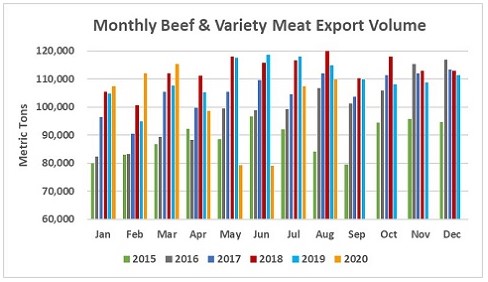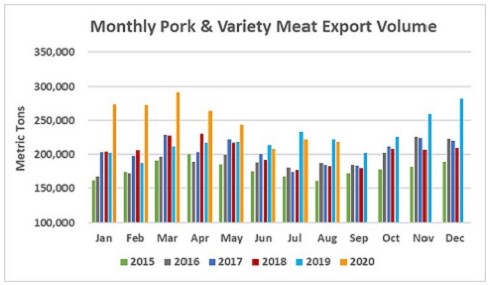August exports of U.S. beef and pork muscle cuts were above last year’s strong volumes, according to data released by USDA and compiled by the U.S. Meat Export Federation (USMEF). Variety meat exports were lower than a year ago, due in part to the lack of available labor required to harvest and export some items.
Led by record-large demand in South Korea and Taiwan, beef muscle cut exports were the largest in more than a year at 89,148 metric tons (mt), up 3.5% year-over-year, while export value increased slightly from a year ago to $611 million. Combined beef/beef variety meat exports were 109,752 mt in August, down 4.5% from a year ago. Export value was $673.8 million, down 2% from a year ago but the highest since March.
For January through August, beef muscle cut exports were 6% below last year’s pace in volume (627,248 mt) and 9% lower in value ($4.38 billion). Beef/beef variety meat exports were down 8% to 808,659 mt, valued at $4.95 billion (down 9%).
Beef export value per head of fed slaughter averaged $302.82 in August, up 1% from a year ago. The January-August average was down 4% to $297.96. August exports accounted for 13.7% of total beef production and 11.9% for muscle cuts, compared to 14% and 11.3%, respectively, last year. The January-August ratios were 13.3% and 11.1%, down from 14.2% and 11.6% a year ago.
August exports of U.S. pork muscle cuts were 180,369 mt, up 1% from a year ago, though value was down 11% to $448.7 million. Combined pork/pork variety meat exports were down 2% in volume (217,893 mt) and 10% lower in value ($528 million). But pork exports remain on a record pace in 2020, with January-August muscle cut exports up 22% from a year ago to 1.68 million mt, valued at $4.45 billion (up 20%). Pork/pork variety meat exports were up 17% in volume to just under 2 million mt, with value up 18% to $5.13 billion.
Pork export value per head slaughtered averaged $47.47 in August, down 12% from a year ago, but the January-August average was still up 15% to $59.59. August exports accounted for 25.9% of total pork production and 23.1% for muscle cuts, down from 27.2% and 23.7%, respectively, last year. January-August ratios remained well above last year at 30% and 27.3% (compared to 26.4% and 23% in 2019).
“The upward trend in muscle cut exports is very encouraging and especially critical as beef and pork production continue to rebound from the interruptions earlier in the year,” said USMEF President and CEO Dan Halstrom. “Maintaining variety meat volumes has been especially challenging this year but we continue to expand and develop destinations for these items, which are essential to maximizing carcass value.”
Halstrom said COVID-19 continues to impact many countries, but the recovery in foodservice is well underway in China and Taiwan and there is progress in other main markets, including Japan and Korea. Even as foodservice activity increases, strong retail and online sales persist.
“Record beef shipments to Korea, Taiwan and China show the kind of rebound U.S. beef can achieve as the foodservice sector gradually recovers and adapts, and we are excited to see demand strengthen further entering the fourth quarter,” he said. “Pork demand is also recovering in some of the regions hardest hit by COVID-19 restrictions, and we see continued export growth in countries where domestic production has been impacted by African swine fever (ASF). U.S. pork is also making significant gains in Japan, including dramatic growth in ground seasoned pork and strong demand for chilled U.S. pork cuts in the regional retail sector.”
Record exports to Korea, Taiwan lead August beef highlights
South Korea was the pacesetter for U.S. beef exports in August, setting new records for volume (27,149 mt, up 22% from a year ago) and value ($183.1 million, up 16%). For January through August, exports to Korea were still down 3% in volume (168,262 mt) and 6% in value ($1.18 billion) from last year’s record pace, due in large part to COVID-19 related impacts on the U.S. supply chain, as well as restrictions on Korea’s foodservice operations. Korea gradually eased restrictions this summer but recently re-imposed some social distancing measures, including limits on gatherings and banquets, which have a negative impact on demand for loin cuts.
Beef exports to Taiwan continued to rebound in August, reaching a record 7,439 mt (up 20% from a year ago) valued at $63.8 million (up 8%). These results pulled January-August exports within 1% of last year’s record pace at 42,529 mt. While export value was down 5% at $364.2 million, a strong finish in 2020 could still push exports to Taiwan to an eighth consecutive value record.
August beef exports to Japan were 26,150 mt, down 9% from a year ago, valued at $155 million (down 6%). Through August, exports to Japan were down 4% in volume (209,570 mt) and 2% in value ($1.37 billion). This was due mainly to a sharp decline in variety meat exports, although variety meat volumes have rebounded from the lows posted in May and June, following U.S. supply chain disruptions. For muscle cuts only, January-August exports to Japan increased 4% from a year ago to 180,592 mt, valued at $1.08 billion (down 2%), with beef short plate exports accounting for much of this growth.
Other January-August highlights for U.S. beef include:
- Beef exports to China set another new record in August at 3,886 mt valued at $28.3 million, more than quadrupling last year’s totals. January-August exports to China were 13,148 mt (up 134% from a year ago) valued at $97.3 million (up 118%), already exceeding full-year totals from 2019. Exports to the China/Hong Kong region increased 7% to 64,644 mt, with value up 1% to $518.3 million.
- Following a down year in 2019, beef exports to Canada continue to gain momentum, reaching 74,387 mt (up 13% from a year ago) valued at $505.7 million (up 14%).
- Exports to Africa, a growing destination for beef livers and other variety meats, rebounded in August at 1,733 mt (up 18% from a year ago). Through August, exports to Africa increased 56% in volume (18,729 mt) and 35% in value ($15.8 million), led by growth in South Africa, Cote d’Ivoire, Gabon, Angola and Ethiopia.
- Exports to Indonesia were 2,644 mt in August, up 24% from a year ago, with muscle cut exports setting a new record at 1,837 mt (up 99%). January-August exports totaled 14,208 mt, down 8% from last year’s record pace, valued at $50.1 million (down 1%).
- Foodservice restrictions and a steep decline in tourism continue to weigh heavily on beef exports to Mexico, though July and August volumes were up sharply from the May low. Through August, shipments to Mexico were down 28% from a year ago to 112,598 mt, valued at $493.8 million (down 32%). Mexico is still the largest volume destination for U.S. beef variety meats, though shipments through August were down 9% from a year ago in volume (56,611 mt) and 16% lower in value ($139.4 million).


Strong August pork exports to Japan; demand rebounding in other key markets
Pork exports to Japan, traditionally the leading value market for U.S. pork, reached 30,247 mt in August, up 7% from a year ago and the largest since April. August export value was $123.5 million, up 3%. For January through August, exports to Japan edged 1% above last year’s pace at 253,362 mt, valued at $1.07 billion (up 4%). Japan’s imports of U.S. ground seasoned pork have rebounded strongly, with value up 48% to $220 million, in reaction to lower tariffs and an increase in Japanese demand for sausages.
August exports to China/Hong Kong fell below the year-ago volume for the first time this year at 61,947 mt (down 3%) valued at $126.2 million (down 8%). August results do not reflect China’s suspension of pork imports from Germany, which was announced Sept. 12 following findings of ASF in wild boars near the Germany-Poland border. Through August, exports to China/Hong Kong still more than doubled last year’s totals in both volume (737,956 mt, up 107%) and value ($1.7 billion, up 136%).
Though August pork exports to Mexico remained below year-ago levels, Mexico reclaimed its position as the largest destination for U.S. pork muscle cuts at 46,462 mt. For January through August, pork/pork variety meat exports to Mexico were 8% below last year’s pace at 435,553 mt, with value down 15% to $701.9 million. Mexico’s demand is critical to the U.S. industry, especially for bone-in hams, of which total exports were record-large in July (61,812 mt) and up 29% from last year in August (54,878 mt). Mexico took nearly 70% of the July-August volume, though exports also increased to China, Canada, the Philippines, Vietnam, Honduras and the Dominican Republic.
Click here to see more...